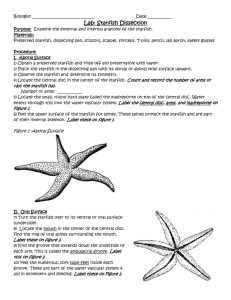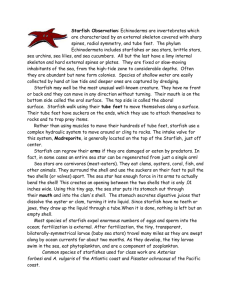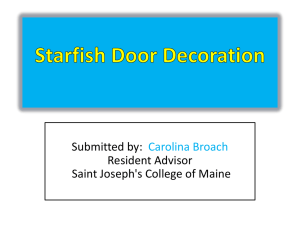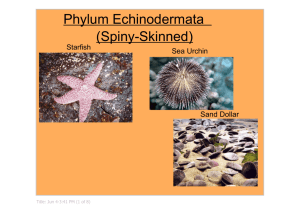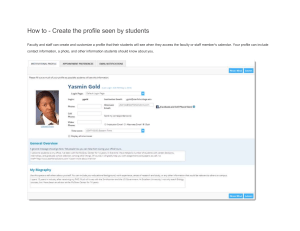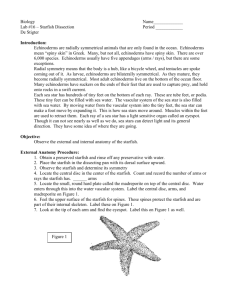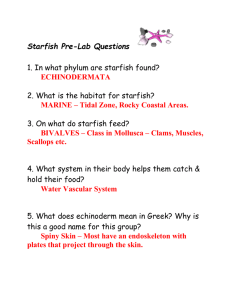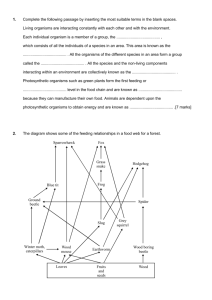Marine Biology Lab: Sea Star Dissection
advertisement
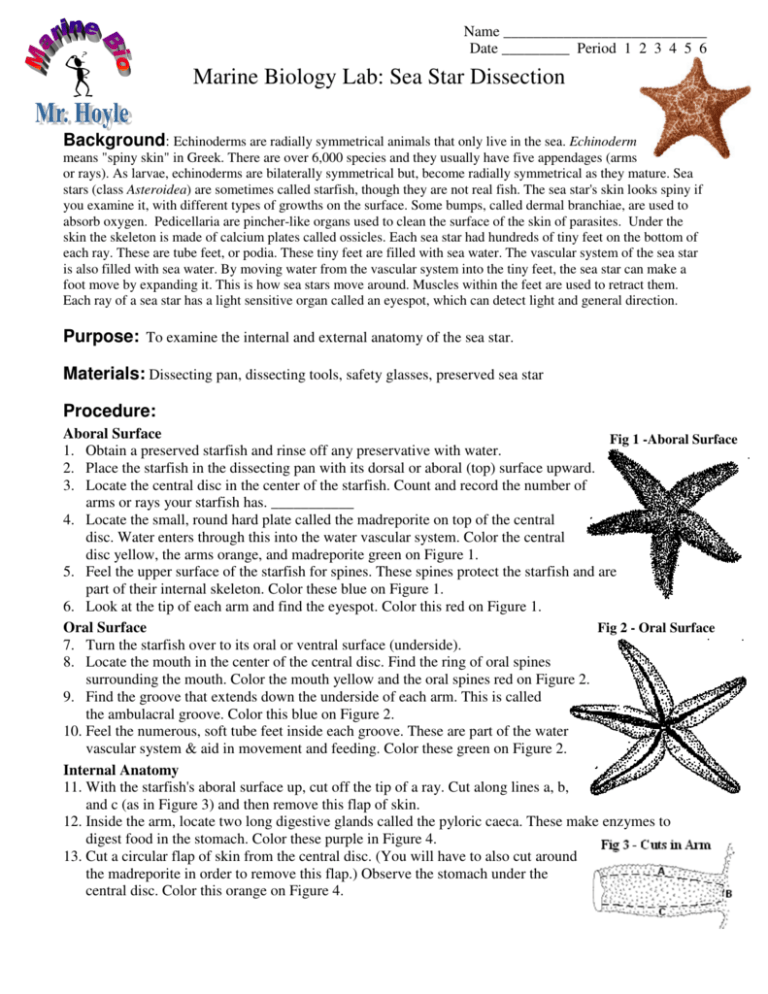
Name ___________________________ Date _________ Period 1 2 3 4 5 6 Marine Biology Lab: Sea Star Dissection Background: Echinoderms are radially symmetrical animals that only live in the sea. Echinoderm means "spiny skin" in Greek. There are over 6,000 species and they usually have five appendages (arms or rays). As larvae, echinoderms are bilaterally symmetrical but, become radially symmetrical as they mature. Sea stars (class Asteroidea) are sometimes called starfish, though they are not real fish. The sea star's skin looks spiny if you examine it, with different types of growths on the surface. Some bumps, called dermal branchiae, are used to absorb oxygen. Pedicellaria are pincher-like organs used to clean the surface of the skin of parasites. Under the skin the skeleton is made of calcium plates called ossicles. Each sea star had hundreds of tiny feet on the bottom of each ray. These are tube feet, or podia. These tiny feet are filled with sea water. The vascular system of the sea star is also filled with sea water. By moving water from the vascular system into the tiny feet, the sea star can make a foot move by expanding it. This is how sea stars move around. Muscles within the feet are used to retract them. Each ray of a sea star has a light sensitive organ called an eyespot, which can detect light and general direction. Purpose: To examine the internal and external anatomy of the sea star. Materials: Dissecting pan, dissecting tools, safety glasses, preserved sea star Procedure: Aboral Surface Fig 1 -Aboral Surface 1. Obtain a preserved starfish and rinse off any preservative with water. 2. Place the starfish in the dissecting pan with its dorsal or aboral (top) surface upward. 3. Locate the central disc in the center of the starfish. Count and record the number of arms or rays your starfish has. ___________ 4. Locate the small, round hard plate called the madreporite on top of the central disc. Water enters through this into the water vascular system. Color the central disc yellow, the arms orange, and madreporite green on Figure 1. 5. Feel the upper surface of the starfish for spines. These spines protect the starfish and are part of their internal skeleton. Color these blue on Figure 1. 6. Look at the tip of each arm and find the eyespot. Color this red on Figure 1. Fig 2 - Oral Surface Oral Surface 7. Turn the starfish over to its oral or ventral surface (underside). 8. Locate the mouth in the center of the central disc. Find the ring of oral spines surrounding the mouth. Color the mouth yellow and the oral spines red on Figure 2. 9. Find the groove that extends down the underside of each arm. This is called the ambulacral groove. Color this blue on Figure 2. 10. Feel the numerous, soft tube feet inside each groove. These are part of the water vascular system & aid in movement and feeding. Color these green on Figure 2. Internal Anatomy 11. With the starfish's aboral surface up, cut off the tip of a ray. Cut along lines a, b, and c (as in Figure 3) and then remove this flap of skin. 12. Inside the arm, locate two long digestive glands called the pyloric caeca. These make enzymes to digest food in the stomach. Color these purple in Figure 4. 13. Cut a circular flap of skin from the central disc. (You will have to also cut around the madreporite in order to remove this flap.) Observe the stomach under the central disc. Color this orange on Figure 4. Name ___________________________ Date _________ Period 1 2 3 4 5 6 14. Remove the pyloric caeca from the arm. Find the gonads (testes or ovaries) Fig 4 - Starfish Digestive & underneath. These may be small if the starfish is not in breeding season. Color Reproductive Systems these yellow on Fig 4. Remove these to see the rest of the water vascular system. 15. Cut off the tip of a ray to observe the parts of the tube feet. Find the zipper-like ridge that extends the length of the ray. The tube feet are attached to these. 16. Locate the bulb-like top of a tube foot called the ampulla. This sac works like the top of an eyedropper to create suction. The bottom of the tube foot is a sucker. Color these blue in Figure 4. 17. Embedded in the soft body wall are skeletal plates called ossicles. Locate these and color green them in Figure 4. 18. Running down the center of each arm is a lateral canal to which tube feet are attached. Color these blue in Figure 5. 19. In the central disc the five lateral canals connect to a circular canal called the ring canal. Find this canal & color it green on Figure 5. 20. A short, canal called the stone canal leads from the ring canal to the madreporite where water enters. Color the stone canal yellow and the madreporite red on Fig 5. 21. Draw a purple arrow on Figure 5 tracing the path that water takes when it enters & moves through the starfish. Fig 5 - Water Vascular System Questions: 1. Name the kingdom, phylum, and class for the starfish you dissected. 2. What is the habitat for starfish? 3. On what do starfish feed? 4. What system in their body helps them catch & hold their food? 5. What does echinoderm mean in Greek? Why is this a good name? 6. Where does water enter a starfish? Where does it leave? 7. On which surface are these parts of a starfish visible: a. Mouth d. Oral spines b. Madreporite e. Eyespots c. Tube feet f. Ambulcaral groove 8. In your own words, describe the path water takes through the water vascular system. 9. What type of skeleton (endo- or exo-) does the starfish have? 10. What bony plates make up its skeleton? 11. What is the function of the pyloric caeca? 12. Where is the stomach of a starfish located? What can the starfish do with its stomach when feeding on clams & oysters? To learn more, check out: http://www.pgjr.alpine.k12.ut.us/science/whitaker/Animal_Kingdom/SeaStar/SeaStar.html http://www.smithlifescience.com/Starfish.htm http://bioweb.uwlax.edu/zoolab/Table_of_Contents/Lab-8b/Starfish_Mount_1/starfish_mount_1.htm

